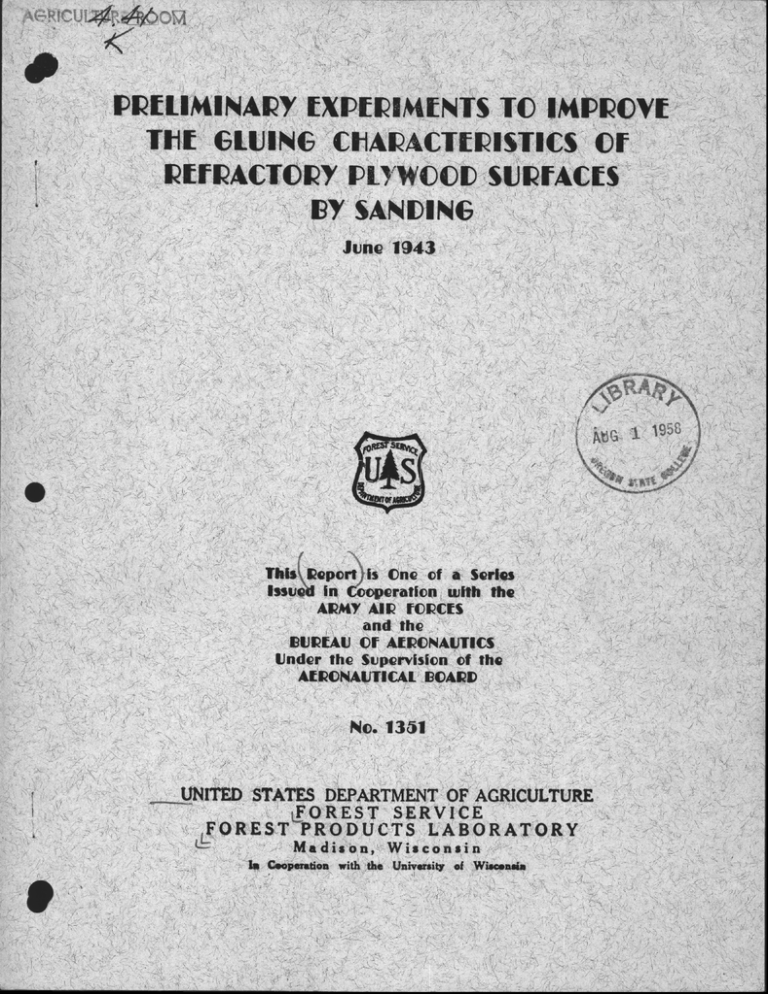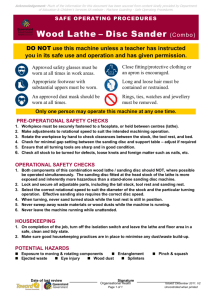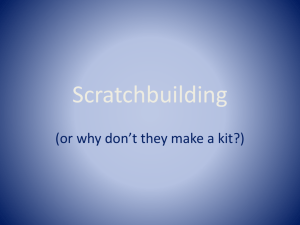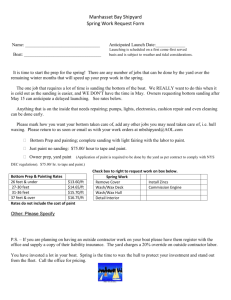IPPELIMINAPY EXPERIMENTS IC IMPROVE THE CLUING CLIAIPACIFEUISTICS CIF 13/ SANDING
advertisement

IPPELIMINAPY EXPERIMENTS IC IMPROVE THE CLUING CLIAIPACIFEUISTICS CIF Pit PACTOPY PLY CCU SURFACES 13/ SANDING June 1943 ThISCrort One of a- Seri" parotid) with the AliMY 411 FORCES iSS14 in andthe laiRtAU 01 AIKNAVTICt Under the Supervision 61 the AuposworicAt OIDAVID No. 1351 • • UNITED STATES DEPARTMENT OF AGRICULTURE SOREST SERVICE fORES(T -PWODAJCT$ LABORATORY Madison, WijiCcitiiin I,/ Cooperation with the University of Wisconsin PRELIMINARY EXPERIMENTS TO IPROVE THE GLUING CHARACTERISTICS OF REFRACTORY PLYWOOD SURFACES BY SANDING1 By F. H. ICAUMRT, Technologist The condition of wood surfaces at the time of gluing has an important influence on the strength of glue joints. Even with the best of woodworking glues and careful gluing technique, strong glue bonds will not result unless the wood, surfaces have been well prepared and are free from contaminating substances and certain physical conditions that may interfere with adhesion of glues. 111 The preparation of satisfactory gluing surfaces on lumber products is not difficult because such materials can usually be planed or otherwise mapchined. Fresh wood surfaces that are smooth, uniform,,, and free from crushed fibers are generally most satisfactory for gluing purposes. Glue joints that develop the full strength of the wood can usually be made on well-planed wood surfaces with acceptable woodworking glues and gluing techniques. Sanding, tooth planing, or other methods of roughening well-planed wood surfaces are unnecessary and inadvisable, and may even decrease joint strength. In contrast to. well-planed normal wood surfaces, plywood sometimes presents more difficult gluing problems although, normally, it can be glued satisfactorily. Surface conditions that may develop during veneer and plywood manufacture and may be accentuated by the techniques used in aircraft assembly gluing are believed responsible for these occasional difficulties. Some of the surface changes that occur in plywood manufacture and may interfere with the adhesion of glue in secondary gluthg are readily recognized. Serious glazing of the surfaces during hot-pressing is usually recognized as undesirable. Heavy bleed-through of glues and similar deposits on the faces of plywood may also interfere to some extent with glue adhesion, Wax deposits from cauls constitute another type of surface condition that is known to affect the quality of glue joints seriously. Excessive squeeze-out of glue during edge-gIuing, of course, also interferes with formation of good joints. Such surface conditions can be largely avoided by changes i4 manufacturing practices. 1-This mimeograph is one of a series o' progress reports prepared by the Forest Products Laboratory to further the Nation's war effort. Results here reported are Preliminary andmaybe revised as additional data become available. Mimeo. No. 1351 -1- In addition to these recognizable surface conditions that interfere with adhesion of glues, however, there appear to be others that are not so easily detected and of which the cause is not yet known. A number of examples of plywood of this type have been received from aircraft fabricators who had experienced difficulty in bonding them strongly together with cold-setting glues in assembly gluing operations. •Numeraus gluing tests have been made on this material at the Forest Products Laboratory and, in many cases, the ex, perience of aircraft fabricators with the plywood in question has been verified. Plywood so tested had been produced by several manufacturers with veneer from different sources. This difficulty has been encountered in yellow birch, sweetgum, Douglas-fir, and yellowpoplar, and most often, though not exclusively, in the heartwoods of these species. The plywood was generally of good quality, and its appearance gave no indication that trouble would be experienced in making satisfactory secondary glue joints to the surfaces. The nature of these unfavorable surface conditions, which probably develop during plywood manufacture, has not been satisfactorily determined, but it is imp ortant that corrective measures be available when the problem is encountered. Light sanding of the plywOod surfaces to be glued is the most effective and practical means thus far found for correcting such unfavorable surface conditions. Various other methods, such as moistening with water, the use of wetting agents, and treatment with chemicals, have been tried but none of them has been found as reliable or as generally effective as light sanding. In investigating the efficacy of light sanding for-improving the gluing characteristics of plywood with which difficulty had been experienced, a number of studies were made. The studies included gluing tests on sanded and unsanded plywood; tests with three different grades of garnet paper; and measurements on the thickness reductions produced by light, medium, and heavy hand sanding: Some of the plywood used in these studies, although it had given difficulty in factory assembly gluing, showed no evidence of surface conditions that would suggest difficulty in secondary gluing, whereas other samples showed glaze, bleed-through, or wax on the faces. In one series of experiments, Sitka spruce cap strips were glued with cold-setting, urea-resin glues by means of nail gluing to strips of plywood that had given trouble. One-half of the plywood strips were lightly sanded with 3-0 garnet paper before gluing and the rest were left in their original condition. Shear specimens were cut from these samples and the quality of the glue joints was determined by shear tests on the type of assembly and shear specimen shown in figure 1. The results of these tests are summarized in table 1. They show that, in every instance, light sanding effected a material improvement in the quality of the glue joints. The improvement was greater in some cases than in • others, but the results indicate that this type of surface treatment largely removed whatever interfering substances or surface conditions were present. Light sanding is obviously hard to define. The danger of over-sanding and consequent reduction in strength has been the p rincipal objection to Mimeo. No. 1351 • sanding aircraft plywood. In order to determine the reduction in thickness of face plies produced by various amounts of sanding, a test was made on four woods. This plywood was of uniform thickness and the face plies were 0.020 inch thick. The sanding was all done across the grain of the face plies with 3-0 garnet paper attached to a sanding block. Three types of sanding, designated as light, medium, and heavy, were used. Light sanding consisted of 10 single strokes across the face ply, medium sanding of 20 strokes, and heavy sanding of 40 strokes. The reductions in face-ply thickness are shown in table 2. It is evident from these results that the same type of sanding reduced the thickness of face plies of wood varying in density to different degrees. Light sanding did not, however, reduce face-ply thickness by more than 0.002 inch, or 10 percent, for any of the species tested. Medium and'heavy sanding, on the other hand, produced greater reductions in thickness, which were possibly sufficient to cause significant strength decreases. Another test was made with different grades of garnet paper, and the reductions in thickness caused by each were measured. The face plies were lightly sanded across the grain by 10 strokes, The reductions in thickness of face plies produced by three types of garnet paper are shown in table 3. It is evident from these results,. that the danger of over-sanding and seriously reducing face-ply thickness decreases with the finer grades of paper. The thickness reductions with 4-0 garnet paper were hard to detect for birch and averaged about 5 percent for the softer species. There is some question whether sanding should be done with or across the grain of the face plies. In sanding the areas to be glued in aircraft plywood, it is usually difficult or impossible to sand with the grain. The tests summarized in table 4 were made to determine whether the same type of sanding would reduce face-ply thickness to a greater extent when done across the grain, at an angle of 45° to the grain, or when sanded with the grain direction. With one possible exception, there was no signiiant difference in reduction in thickness of face plies sanded in the three different directions. In an attempt to determine the amount of sanding required to produce satisfactory gluing surfaces on plywood that could not be well glued without some face treatment, the experiment summarized in table 5 was made. The faces of the plywood used were first given a thin coating _of floor Wax to produce an extremely unfavorable gluing condition. Such surfaces would rarely, if ever, be met on „aircraft plywood but they afforded a good . test medium. Sanding was done with 3-0 garnet paper and reductions in face-ply thickness by the three types of sanding practices, light, medium, and heavy, were in the range of those given in table 2. The results in table 5 show that light sanding produced great improvement in every case and was generally about as effective. and produced about as favorable gluing surfaces as did medium or heavy sanding. These results are in line with those obtained in other tests on plywood having surfaces that were not readily glued. The results for yellowpoplar in table 5 indicate some improvement for medium sanding as compared with light sanding. IIP Mimeo, No. 1351 -3- This may have resulted from deeper penetration of the wax in the yellowpoplar and its better removal by the additional sanding. Table 6 compares the effects produced by different amounts of sanding with several grades of garnet paper on the gluing characteristics of plywood that had been found difficult to glue without some surface treatment. The sweetgum heartwood used in these tests had what appeared to be normal surfaces and the mahogany had heavy bleed-through of glue or other materials over its entire surface. All sanding was done across the grain. The plywood was nailglued to spruce cap strips with cold-setting, urea-resin glue. The results of these tests corroborate those given above and indicate that light sanding, with 4-0 or 3-0 garnet paper,is as effective and produces as great an improvement in gluing characteristics of plywood that is normally hard to glue as does heavy sanding with the same grade of paper or with coarser papers. In all the sanding studies reported here, the sander dust was removed with a clean cloth or brush. No special effort was made to remove sander dust from the pores and no interference with adhesion of glues was observed. Summary Light hand-sanding of plywood surfaces has been found very beneficial in correcting surface conditions that interfere with the adhesion of coldsetting glues in aircraft-assembly operations. Light sanding should riot be considered a cure-all but a useful aid in correcting the gluing characteristics of plywood otherwise difficult to glue. The danger of over-sanding can be reduced by specifying the use of sandpaper no coarser than 3-0 garnet on species of high density and no coarser than 4-,0 garnet on species of low density. Reductions in face-ply thickness should never exceed 10 percent and whenever possible should be limited to .0.001 inch. Frequent thickness measurements are advisable when hand-sanding is practiced. In order to be of the maximum value, light sanding should follow masking and sealing operations. Mimeo. No. 1351 -4- • Figure 1.--Nail-gluing assemblies. A, top view of assembly with nailing strip in place; B, bottom view of assembly showing spruce cap strip; A-1, A-2, and. A-3, top view of shear specimens cut from assemblies such as A and B; B-1, B-2, and B-3, bottom view of similar shear specimens. 481,',7 Z 7 O Table 1.--Results of shear tests on sanded and unsanded plywood nail-glued - to Sitka spruce cap strips with a cold- gio urea Plywood. species : Breaking? : Wood Surface Appearance : :of surfaces : treatment : strength : failure :Pounds per : Percent :square inch: : 28 99 : None : Normal Yellow birch : Do...... . • ' do.....:Light sanding: 364 520 : 340 .do.....:Light sanding: 628 : Sweetgum None (heartwood) :.....do.....; Do. .:.....do.....:Light sanding: 420 500 63 : : 100 : None sanding: 389 519 : : 1464 on the None : faces .,do..... :Light sanding: 186 445 Sweetgum (heartwood) Do s' do.... . : None 45 98 e Mahogany : Heavy bleed-: : :through Do........:....,do.....:Light Mahogany Do. 30 99 0 53 1 –Comparisons are between sanded and unsanded samples of the same lot and not between species or lots because the plywood panels were of different thicknesses and constructions. 2-Each average is for 9 or more shear specimens cut from 3 or more nail-glued assemblies of the type shown in figure 1. Mimeo, No. 1351 • • Table 2.--Reduction in face-Ply thickness produced by sanding 0.020-inch faces of lywood with 3-0 garnet paperl Reduction in face-ply thickness Species Light sanding : Medium sanding : Heavy sanding (10 strokes) : .(20 strokes) : (40 strokes) r : Inch : Percent: Inch : Percent .• *. Yellow birch :0.0005: Sweetgum : .001 ; Yellowpoplar : .002 : Douglas-fir : .002 : Inch Percent : .• 4 5 10 10 :0.002 : : .002 : : .004 : : .004 ; 10 10 20 20 :0.004 : • .006 . : : .007 : : .005 : 20 30 35 25 1 –Each value is an average of thickness measurements on 5 plywood strips of the type used in nails,gluing tests (fig. 1). Sanding was done by hand, across the grain. Table 3.--Reduction in face-ply thickness produced by lightly sanding 0.020-inch faces of •'wood with different trades ofpri Grade of garnet paper Species 4-0 ,3-0 2-0 : Inch : Percent: Inch Percent : Inch : Percent Yellow birch Sweetgum Yellowpoplar Douglas-fir : :0,00 .001 .001 .001 : : : 0 5 5 5 :0.001 : : .002 : : .002 : : .001 5 10 10 5 :0,002 : .003 : : .003 : : .004 : 10 15 15 20 lEach value is an average of thickness measurements on 5 plywood strips of the type used in nail-gluing tests (fig. 1), Sanding was done by hand, across the grain. • Mimeo. No, 1351 Table 4.--Reduction in thickness of face plies of plywood with faces 0 020-inch thick br sanding with, at right 2,12E12.221aqE2I25 .0 to the grain; all sanding done IJALLLliPEEL2(222:faUL.1L11LEnding 10 strokes across the face), Reduction in face thickness by sanding Species . ::-----With grain : 90° to grain : 45° to grain Percent: Inch : Percent, : Inch : Percent Yellow birch :0.001 : 5 :0.001 : 5 :0.001 : 5 Sweetgum 5 : .002 : 10 : .002 : 10 10 : .002 : 10 10 5 : .001 : : .002 : .001 : .001 : Yellowpoplar : .002 : Douglas-fir : .001 • 5 : 5 1 -Each set of values is an average of thickness measurements on 5 plywood strips of the type used in nail-gluing tests (fig. 1). Mimeo. No. 1351 Table 5.--Effectiveness of light, medium, and heavy , sanding in im roving the .uality of 'lue oints made on waxaper. coated plywood. Sandie done Joint strengths and wood failures species obtained with 2 types of glues : Sanding :Casein glue :Cold-setting, urea- : resin glue : Wood : Joint : Wood : Joint : strength : failure : strength : failure per : Percent, : Lb...2 2232 : Percent • Yellow birch : None Do.......: Light Do ..... ..: Medium Do.......: Heavy .: ,. .: 1 0 606 534 576 Sweetgum .: None Do.......: Light Do.......: Medium Do... • • • • : Heavy : : : .. 0 515 514 466 : : : . : : : Douglas-fir : None : .. Do.... .. .: Light Do.......: Medium : Do . : Heavy 116 454 576 510 : : : 0 504 504 520 : : : Yellowpoplar : None Do,. •: Light Do ..: Medium Do.. • Heavy • : : • : . : .: : 0 526 560 574 : : : 0 93 95 75 : 0 : 38 :. 93 63.. 66 396 510 526 : : : : 0 50 82 97 136 556 430 586 : : : : 0 43 92 83 0 83 100 67 : 0 48 33 100 0 600 574 596 0 67 72 97 •. 0 43 77 100 : : : • : , 1 Each value is the average for 9 or more shear specimens cut from 3 or more nail-gluing assemblies of the type shown in figure 1. Mimeo. No. 1351 Table 6.--Effect of light and heav y sanding with different grades of garnet pap er on the quality of glue joints made on sweetgum heartwood plywood and mahogany plywood with a cold-setting, urea-resin glue: Kind of plywood : Joint : Wood. Reduction in : Grade of :Type of: :garnet paper:sanding:face-ply thickness:strength:failure Percent Sweetgum heartwood plywood : .. • • 4-0 4-0 3-0 3-0 2-0 2-0 : : Control Mahogany : plywood with ; heavy bleed- : through 4-0 3-0 2-.0 •• Control . ' : Light : : Heavy : . ; : Light : : Heavy : :Lb. per :Percent 4.0 12.0 . : 707 : 643 4.0 17.0 : 615 : 661 : : 77 55 72 85 98 98 : Light : : Heavy : .. : None • 9.0 30.0 : 638 : 628 None 442 23 : Light : : do....; : do... .• • 5.0 4.0 8.0 : 666 : 660 : 710 . 98 97 : : 100 None 400 : None ; : : 5() , --leen average based on 12 shear specimens cut from 4 assemblies of the type shown in figure 1. Mimeo. "Yo. 1351 410





